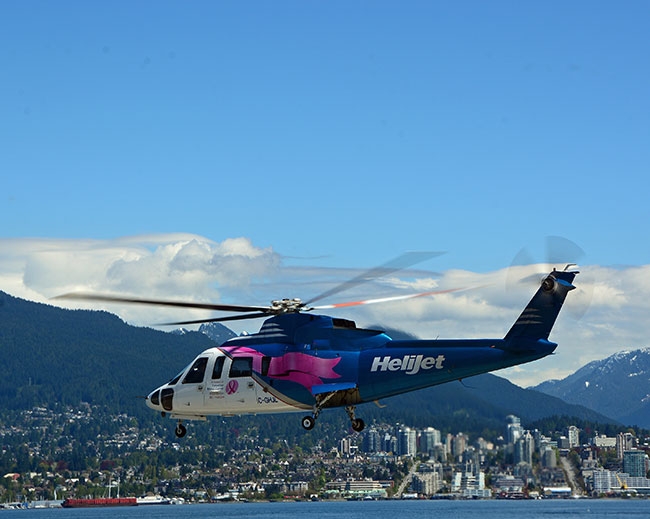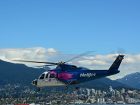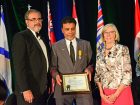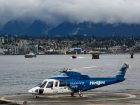
Features
Commercial
Operator Profiles
An Incredible Journey
October 11, 2017 By Paul Dixon
In June of this year, Danny Sitnam, president and CEO of Helijet International Inc., was inducted into Canada’s Aviation Hall of Fame at the CAHF’s 44th annual Gala Dinner. The event was held on the departures level concourse at Vancouver International Airport (YVR).
 Helijet is still flying its two original S-76As In June of this year
Helijet is still flying its two original S-76As In June of this yearThe Vancouver Police Department Pipe Band behind an honour party that included The Honourable Judith Guichon, Lieutenant Governor of British Columbia, escorted the 2017 inductees, Errol Boyd, Robert Deluce, Rogers Smith and Sitnam into the dinner.
The formal notice from the CAHF of his induction began, “As a helicopter pilot and entrepreneur, Danny Sitnam has built Helijet International Inc., to become the world’s largest scheduled helicopter passenger service, also offering rotary and fixed wing aircraft for charter and medical service. Danny is known for leadership, professionalism and his interest in offering growth opportunity for his employees.”
In his remarks to the audience, Danny had little to say about himself and much to say about the people that have been there with him – and for him – on this journey. In a voice tinged with emotion, he spoke of his parents, brother, business partners and employees at Helijet, and his wife and children.
Ten days after the dinner, we sat in Danny’s office and he was still mulling over the evening. “It hasn’t hit me yet, but it will. I think about the inductees and what they’ve done, the stories I heard that evening and the people I met.” Danny Sitnam speaks softly and while he laughs easily, there is intensity within him. You can see it in his eyes, always alive and alert. On the wall of his office is a poster-sized photo of the Aérospatiale Gazelle, the acorn from which Helijet International sprouted.
The young Danny Sitnam trained as a machinist but got the flying bug after his first ride in a helicopter. A week after completing his training, he found himself ferrying that same helicopter north to the Yukon. Jump ahead a few years, he was back in North Vancouver and owned that Gazelle with a couple of partners.
They tried to make a dent in the world of corporate aviation, but it didn’t go too well as he recalled. “It was just like pouring water down a hole. We were going nowhere with this helicopter,” he says. “That helicopter was more of a recreational toy that we really couldn’t afford.”
Where many others would have given up and gone to work for someone else, the partners came up with an even bolder plan. It was something even riskier and took even more money, but they saw it as a better business opportunity. They were going to start a scheduled helicopter service between Vancouver and Victoria.
Baby Steps
The early years in the 1980s weren’t kind to businesses in B.C. as the province was riding its way through another recession that saw interest rates hit over 20 per cent for commercial lending. “It was a challenge,” Sitnam says in a slight understatement. “Everything had to be funded by ourselves, or at least by my partners. There was no way the banks were going to finance the deal.”
Thinking back on examples of operators who had tried scheduled helicopter services around the world, Sitnam chuckles at what a potential investor would have seen. “They all failed,” he said. “New York Airways, Chicago Airways, LA Airways, all the helicopter start-ups that tried to do urban, city-centre operations. They all failed for one reason or another and we wanted to start this business in Vancouver?” There was also the matter of competing with the established seaplane operators. The kinder bankers at least wished him “good luck” before showing him the door.
It was during the startup phase that Sitnam learned the value of human capital, making investments that cost little in terms of dollars and cents, but can pay huge dividends in the future. John Munro, then a member of fledgling Helijet’s board of directors, encouraged Sitnam to meet with Ian Harris of Air BC, which at that time operated Twin Otters on the Vancouver-Victoria route.
“It was at a little Italian restaurant,” Sitnam recalls. “We broke the news to him and he looked at us and said – you’re really going to do this? We said we were going to give it a try and after a brief pause he wished us good luck.”
Up to this point, Sitnam had only thought about the level of service he was going to offer and how operating standards and technology would be their selling point. “I really didn’t think much about price (in the beginning), but what he did (Munro) was give us a chance to get off the ground, so to speak. If he had wanted to, he could have slashed his prices and killed us in 90 days. He allowed us to get traction and develop the market and then we could ratchet the fares up to a point where we could live.”
Hardware Decisions
Finding a helicopter was the next hurdle. Aircraft owners were underwhelmed by the group’s prospects, Sitnam recalls. “Anyone that owned aircraft, just wasn’t interested,” he said. “They couldn’t understand how they were going to get paid. You’re starting at broke and you’ve got no revenue base.”
But fortune smiled, if only briefly, on the team. Sitnam knew a Vancouver-area business that had a Bell 412 coming back from an overseas lease and he was able to secure it. So, in November 1986, Helijet launched its passenger service with that one 412 offering working the Vancouver-Victoria route. The result? There was but one paying passenger on the first flight.
“It was four months later and we couldn’t pay our bills. I couldn’t make the lease payments on the aircraft and things got a little strained,” Sitnam says. The bills eventually got paid, and in one of those fortuitous strokes of timing, Sikorsky entered the picture in the person of Jack Donohue.
“Jack was instrumental in coming out here and paying attention to what was happening out here,” Sitnam says. “They had some aircraft at Sikorsky that they were redeploying and he convinced his higher ups to support this little company in Vancouver. He thought that the S-76 was the right type of aircraft for the mission we were doing. He was an advocate for his aircraft being a better fit for Helijet and he was able to convince Sikorsky management to take a chance with us.”
Moving Mountains
Today, more than 30 years later, Helijet is still flying its two original S-76As, each with more than 40,000 hours of service. “They’ve served us well,” Sitnam says. “Sikorsky is a very solid aircraft, a very forgiving aircraft from a pilot’s perspective.”
At the 2017 HAI Heli Expo, Sikorsky recognized Helijet for 30 years of safe, scheduled airline and charter operations with its fleet of S-76 helicopters. From its very humble beginnings, the company has grown to 160 full-time employees and the fleet has expanded from its original pair of S-76 helicopters to a more diverse setup of several smaller helicopters and two fixed-wing corporate jet aircraft.
Scheduled service now includes a Vancouver-Nanaimo route, with more than 300 weekly flights on the Victoria-Vancouver route. And since 1998, Helijet has provided air ambulance service to BC Ambulance from bases in Vancouver and Prince Rupert. Over those 19 years, they have more than 25,000 flight hours with more than 50,000 patients, flying IFR 24/7 in some of the most challenging terrain in the world.
Over the same period, Helijet has established itself on the north coast of B.C., by providing service to many of the world-famous fishing lodges and resorts in Haida Gaia on B.C.’s Central Coast. The lodges are isolated in remote locations. The natural beauty of the region is unmatched, but it is a very different environment that operating in the two-pilot, IFR routes of southern B.C.’s controlled air space.
“The work is hard,” Sitnam says, “especially if you look at it from a risk perspective. It’s single pilot, VFR, without all the resources you have around you down here (in Vancouver). It’s raw flying, where you’re on your own (as a pilot) if something goes wrong. It’s pretty much always a full load both ways, with either people or fish on board. We spend a lot of time thinking about how to protect the people and the equipment.”
Helijet operates a year-round base at Sandspit Airport, along with mission-specific helicopters and flight crew to serve a wide range of businesses.
The fishing lodge business starts up in late spring and runs through to early September, which makes it a good fit for the company, as the passenger load on the Vancouver-Victoria routes tends to drop over the summer. So, has there been any direct conflict with seaplane operators on the scheduled routes over the years?
“Not really,” notes Sitnam. “I don’t think we took a lot of traffic from the seaplane operators back then or even today. We have a few that move back and forth, depending on the season. The seaplanes have more service in the summer with the longer days and we get them back in the winter because we can fly a longer day with IFR and in heavier weather.”
As much as anything, Helijet attracted what Sitnam calls “a new fan base” from the region. It’s mainly business travellers who understand the concept of time being money and not being willing to spend time travelling by ferry or airport-to-airport. Downtown to downtown becomes very attractive.
While Helijet’s corporate offices and hangar are on the south side of YVR, the “downtown” terminals in Vancouver, Victoria and Nanaimo are the domain of Pacific Heliport Services, a subsidiary of Helijet. The current heliport in downtown Vancouver was built by Transport Canada (TC) in 1986 for a number of corporate uses as well as Helijet. Ironically, after many years of lobbying TC for the facility, by the time it opened for business, many of the companies that had been operating their own dedicated rotary assets were getting out of the aviation business. By 1988, Helijet was the dominant user of the facility.
“We wanted to expand the facilities, but the management didn’t want to, so we bought them out,” Sitnam says. “It’s our people, servicing our own aircraft. It was academic and it seems to work.” The Vancouver heliport exists in a very desirable neighbourhood, adjacent to the SeaBus terminal and Vancouver’s Trade and Convention Centre.
Coming Full Circle
For Sitnam, the induction to Canada’s Aviation Hall of Fame is one more in a long list of accolades, stretching back over time. In 1994, Helijet received the Community Service Award from Helicopter Association International (HAI) and in 2000, Sitnam received the Robert S. Day Trophy from the British Columbia Aviation Council (BCAC) in recognition of “outstanding contribution in the leadership and development of aviation in B.C.”
Two years ago, Helijet received the BCAC’s Environmental Award in Aviation in recognition of “environmental initiative, program or accomplishment in one of more areas of protection, rejuvenation, conservation and awareness.” Specifically, the award recognized Helijet for deliberately flying approach and departure routes in Victoria and Vancouver that minimized the noise impact on local residents. Taking circuitous routes meant flying higher, more fuel burn and adding a few more minutes to the routes, but more importantly, the neighbours were happy.
In 2016 at the BC Aviation Councils Silver Wing Awards dinner, Sitnam received the BCAC Lifetime Achievement Award. He also announced that Helijet was establishing an annual $3,500 bursary to enable mid-career helicopter pilots or AMEs to complete further training or certification to further their careers.
In the community at large, Helijet has an equally long history of providing sponsorship or partnering with charities.
“Things I enjoy the most are on the sponsorship side,” Sitnam says. “For example, the 1994 Commonwealth Games (in Victoria), where we painted our aircraft up with their mascot. The (2010) Olympics was memorable, though our involvement was through the air ambulance side.”
On the charity side, Helijet supports breast cancer and prostate cancer, “giving back to the community.” As Sitnam notes, “we’ve raised more than $100,000 to date for breast cancer, with $.50 of every ticket going to the Breast Cancer Association. With Prostate Cancer, we’ve liveried out an aircraft and participate in as many promotions with them as we can do.”
Then there’s Helijet’s role in making sure that Santa gets to visit children in area hospitals when his reindeer are grounded. It’s a new initiative that has piqued the interest of Power To Be, a group with offices in Vancouver and Victoria that works with people who are disabled and can’t enjoy the outdoors.
Broadening Horizons
So, what’s in the future for Helijet? “When I look at opportunities for growth, I don’t see that many,” Sitnam says. He has had inquiries from around the world about introducing the Helijet brand, but it’s a tough business to grow out. “Like everything in the airline business, it’s a tough place to make money, whatever you’re flying.” The problem is, as he explained, is that these people want you to put the money in to develop the business. At his point, he says they’re not interested in taking on that risk.
There are a couple of lessons that Sitnam has learned along the way and has taken to heart. For one, you need to take care of yourself, so that you can be there as a leader. “You can’t always be the caboose,” he says. “It took me a long time to learn that lesson. You need to make sure you’re healthy and your family is healthy and strong. We’re fine, but it could have gone better.”
The second lesson is getting the right people around you. “That’s really important in business, having people in the company that have their particular skills and can do them better than you ever could.” This trait is reflected in the people who have been with Helijet from the beginning or soon after. Sitnam notes that Helijet indeed has staff turnover – just like any other company – but if you look at the top couple of layers there has been a remarkable degree of
stability over the years.
What does the future hold for Sitnam? Danny and his family spent January and February in Africa, visiting his brother, who is the director of World Vision International in Africa. You can hear the impact this visit had on him when he speaks, just like that first Bell 412 so many years ago. The visit has also got him thinking again.
“I wonder how we could get involved in helping communities that are in need, using helicopters and technology?” Can we move into that area and add some value?”
Stay tuned . . . this story is far from over.


